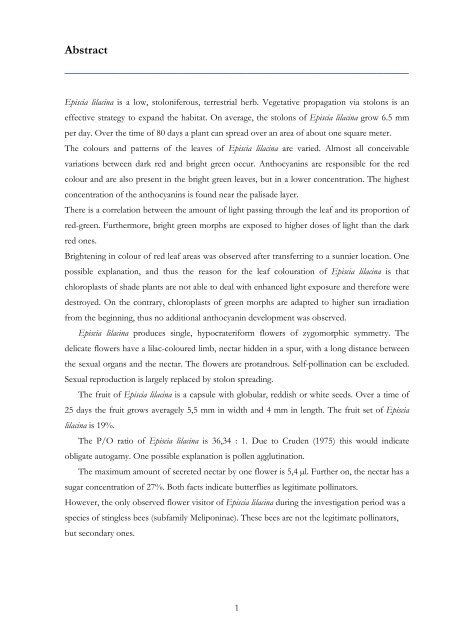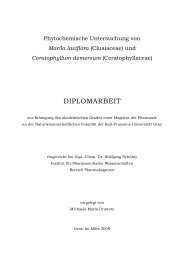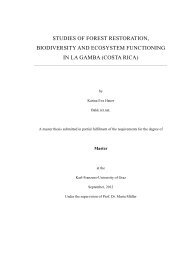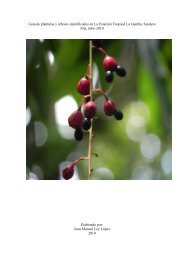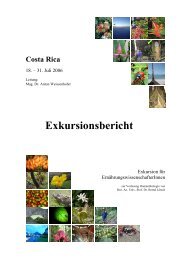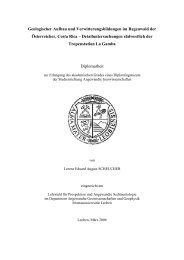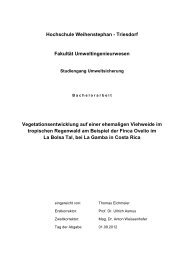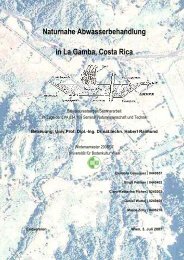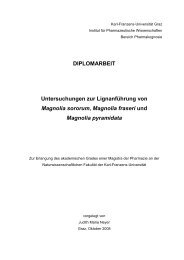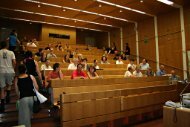Leaf colour patterns, vegetative and sexual reproduction of Episcia ...
Leaf colour patterns, vegetative and sexual reproduction of Episcia ...
Leaf colour patterns, vegetative and sexual reproduction of Episcia ...
Create successful ePaper yourself
Turn your PDF publications into a flip-book with our unique Google optimized e-Paper software.
Abstract<br />
________________________________________________________________<br />
<strong>Episcia</strong> lilacina is a low, stoloniferous, terrestrial herb. Vegetative propagation via stolons is an<br />
effective strategy to exp<strong>and</strong> the habitat. On average, the stolons <strong>of</strong> <strong>Episcia</strong> lilacina grow 6.5 mm<br />
per day. Over the time <strong>of</strong> 80 days a plant can spread over an area <strong>of</strong> about one square meter.<br />
The <strong>colour</strong>s <strong>and</strong> <strong>patterns</strong> <strong>of</strong> the leaves <strong>of</strong> <strong>Episcia</strong> lilacina are varied. Almost all conceivable<br />
variations between dark red <strong>and</strong> bright green occur. Anthocyanins are responsible for the red<br />
<strong>colour</strong> <strong>and</strong> are also present in the bright green leaves, but in a lower concentration. The highest<br />
concentration <strong>of</strong> the anthocyanins is found near the palisade layer.<br />
There is a correlation between the amount <strong>of</strong> light passing through the leaf <strong>and</strong> its proportion <strong>of</strong><br />
red-green. Furthermore, bright green morphs are exposed to higher doses <strong>of</strong> light than the dark<br />
red ones.<br />
Brightening in <strong>colour</strong> <strong>of</strong> red leaf areas was observed after transferring to a sunnier location. One<br />
possible explanation, <strong>and</strong> thus the reason for the leaf <strong>colour</strong>ation <strong>of</strong> <strong>Episcia</strong> lilacina is that<br />
chloroplasts <strong>of</strong> shade plants are not able to deal with enhanced light exposure <strong>and</strong> therefore were<br />
destroyed. On the contrary, chloroplasts <strong>of</strong> green morphs are adapted to higher sun irradiation<br />
from the beginning, thus no additional anthocyanin development was observed.<br />
<strong>Episcia</strong> lilacina produces single, hypocrateriform flowers <strong>of</strong> zygomorphic symmetry. The<br />
delicate flowers have a lilac-<strong>colour</strong>ed limb, nectar hidden in a spur, with a long distance between<br />
the <strong>sexual</strong> organs <strong>and</strong> the nectar. The flowers are prot<strong>and</strong>rous. Self-pollination can be excluded.<br />
Sexual <strong>reproduction</strong> is largely replaced by stolon spreading.<br />
The fruit <strong>of</strong> <strong>Episcia</strong> lilacina is a capsule with globular, reddish or white seeds. Over a time <strong>of</strong><br />
25 days the fruit grows averagely 5,5 mm in width <strong>and</strong> 4 mm in length. The fruit set <strong>of</strong> <strong>Episcia</strong><br />
lilacina is 19%.<br />
The P/O ratio <strong>of</strong> <strong>Episcia</strong> lilacina is 36,34 : 1. Due to Cruden (1975) this would indicate<br />
obligate autogamy. One possible explanation is pollen agglutination.<br />
The maximum amount <strong>of</strong> secreted nectar by one flower is 5,4 µl. Further on, the nectar has a<br />
sugar concentration <strong>of</strong> 27%. Both facts indicate butterflies as legitimate pollinators.<br />
However, the only observed flower visitor <strong>of</strong> <strong>Episcia</strong> lilacina during the investigation period was a<br />
species <strong>of</strong> stingless bees (subfamily Meliponinae). These bees are not the legitimate pollinators,<br />
but secondary ones.<br />
1


